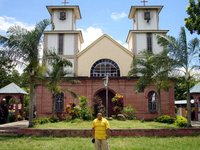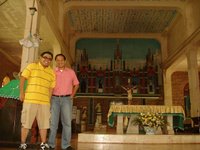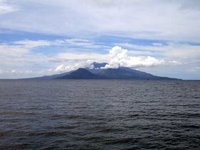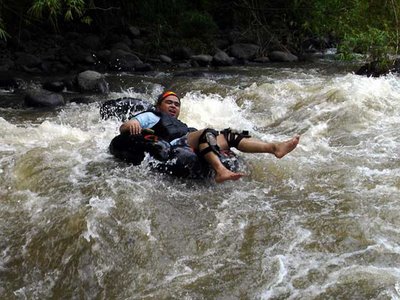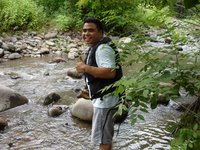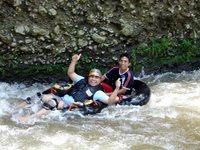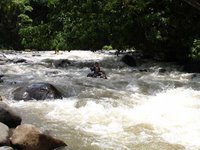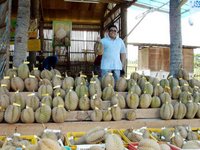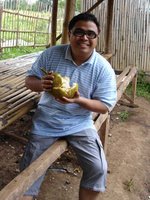Before I flew down south to Davao Occidental, a new province carved out of Davao del Sur, the area had been experiencing torrential rains. People were actually discouraging me from pushing through, suggesting to move the trip a week later. But gut feel told me to go. And I was blessed with several days of sun. For my third day, we explored Jose Abad Santos, Davao Occidental, the southernmost municipality of Mindanao Island.
I had arrived the day before after a three-hour drive from Malita, through rough mountain and coastal roads in Don Marcelino, before reaching Jose Abad Santos or JAS. After breakfast that morning, we visited the old municipal hall of JAS, over fifty years old, which the locals preserved and hope to get declared. Note that they built a new municipal hall a few meters away and kept their old one.
We drove to the next barangay and spent the whole morning in Culaman Beach where the Joyce Ancestral House is located, exploring the nearby beaches, a picturesque mix of sand and rock. It was a pleasant trek through the rocky shoreline. But you need to be careful though since you can easily lose your balance.
Further down the coastline, there was one relatively white sand beach in a small cove. Near it, we sat under a tree, enjoying the warm sea breeze and the sound of waves hitting the shore.
Some locals brought us coconuts, a refreshing treat after that short walk under the hot sun.
Before going back to the Joyce House, we passed by the parola, the recently-built Culaman Lighthouse, which offers a spectacular view of Culaman's shoreline. Lunch was at a kubo beside the house. I could have stayed there the whole day and just stared at the view!
After lunch, I was brought back to Malita for me to catch a bus to Davao City. But I took more photos along the way, especially in Barangay Mangile and the Lawayon Plantation. Of course, I enjoyed the views of the vast coconut plantations and rice fields from high up the National Highway. But every now and then, you'd get reminded of the old forest cover of the area that was cleared for these plantations, when you see a large centuries-old tree.
I made it back in time for the 3:30 p.m. bus (no more aircon buses) to Davao. I decided to get a ticket to Digos and wait for a more comfortable and faster ride from there which was a good move since it only took me an hour to get back. All in all, it took over five hours from JAS to Davao City. By the time the bus arrived at Ecoland, it was raining again.
That was a good trip! I'm definitely coming back to Davao Occidental to see Balut Island and Sarangani Island, and the southern barangays of JAS which I was told has better beaches!
Part 1 - Davao Occidental: Road adventure to Santa Maria, Malita, Don Marcelino & Jose Abad Santos
How to get to Davao Occidental
There are regular buses to Santa Maria and Malita from the Ecoland Bus Terminal in Davao City. I paid Php213 for the air-conditioned ride from Davao to Malita. From Malita, there are buses to Don Marcelino. To get to Jose Abad Santos, you can take a van from Malita (although the service is not regular) or from Davao City which costs Php500. But you will need to know the number of the van drivers since they are private vans which will pick you up from your hotel in Davao. Contact Junjun at (0928) 2645527.
Where to stay in Jose Abad Santos
There is only one place to stay in JAS. You may contact Traveller's Inn at (0908) 8855687.
Thank you to the family of Rep. Franklin P. Bautista, JAS Mayor Jimmy Joyce and Atty. Jason Joyce for their warm hospitality!
I had arrived the day before after a three-hour drive from Malita, through rough mountain and coastal roads in Don Marcelino, before reaching Jose Abad Santos or JAS. After breakfast that morning, we visited the old municipal hall of JAS, over fifty years old, which the locals preserved and hope to get declared. Note that they built a new municipal hall a few meters away and kept their old one.
We drove to the next barangay and spent the whole morning in Culaman Beach where the Joyce Ancestral House is located, exploring the nearby beaches, a picturesque mix of sand and rock. It was a pleasant trek through the rocky shoreline. But you need to be careful though since you can easily lose your balance.
Further down the coastline, there was one relatively white sand beach in a small cove. Near it, we sat under a tree, enjoying the warm sea breeze and the sound of waves hitting the shore.
Some locals brought us coconuts, a refreshing treat after that short walk under the hot sun.
Before going back to the Joyce House, we passed by the parola, the recently-built Culaman Lighthouse, which offers a spectacular view of Culaman's shoreline. Lunch was at a kubo beside the house. I could have stayed there the whole day and just stared at the view!
After lunch, I was brought back to Malita for me to catch a bus to Davao City. But I took more photos along the way, especially in Barangay Mangile and the Lawayon Plantation. Of course, I enjoyed the views of the vast coconut plantations and rice fields from high up the National Highway. But every now and then, you'd get reminded of the old forest cover of the area that was cleared for these plantations, when you see a large centuries-old tree.
I made it back in time for the 3:30 p.m. bus (no more aircon buses) to Davao. I decided to get a ticket to Digos and wait for a more comfortable and faster ride from there which was a good move since it only took me an hour to get back. All in all, it took over five hours from JAS to Davao City. By the time the bus arrived at Ecoland, it was raining again.
That was a good trip! I'm definitely coming back to Davao Occidental to see Balut Island and Sarangani Island, and the southern barangays of JAS which I was told has better beaches!
Part 1 - Davao Occidental: Road adventure to Santa Maria, Malita, Don Marcelino & Jose Abad Santos
How to get to Davao Occidental
There are regular buses to Santa Maria and Malita from the Ecoland Bus Terminal in Davao City. I paid Php213 for the air-conditioned ride from Davao to Malita. From Malita, there are buses to Don Marcelino. To get to Jose Abad Santos, you can take a van from Malita (although the service is not regular) or from Davao City which costs Php500. But you will need to know the number of the van drivers since they are private vans which will pick you up from your hotel in Davao. Contact Junjun at (0928) 2645527.
Where to stay in Jose Abad Santos
There is only one place to stay in JAS. You may contact Traveller's Inn at (0908) 8855687.
Thank you to the family of Rep. Franklin P. Bautista, JAS Mayor Jimmy Joyce and Atty. Jason Joyce for their warm hospitality!













































